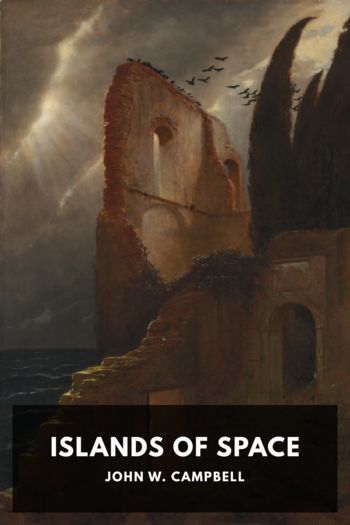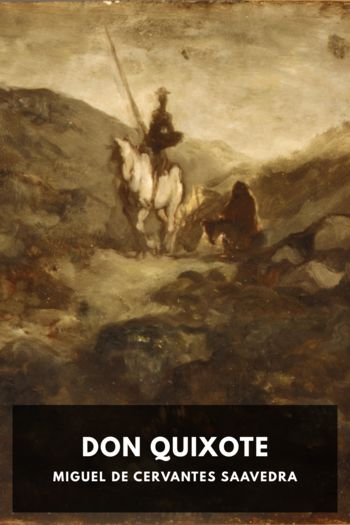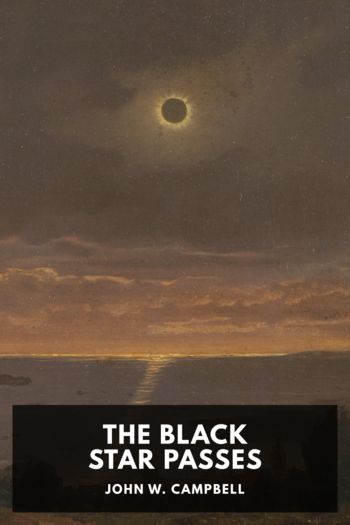Islands of Space, John W. Campbell [self help books to read TXT] 📗

- Author: John W. Campbell
Book online «Islands of Space, John W. Campbell [self help books to read TXT] 📗». Author John W. Campbell
“More than that,” said Morey. He pointed at the screen. “See here, how Mars is placed in relation to Venus and Earth? The planets were in that configuration seven years ago. We’re seven light years from Earth.”
“Good enough!” Arcot grinned. “That means we’re within two light years of Sirius, since we were headed in that direction. Let’s turn the ship so we can take a look at it with the telectroscope.”
Since the power had been cut off, the ship was in free fall, and the men were weightless. Arcot didn’t try to walk toward the control room; he simply pushed against the wall with his feet and made a long, slow dive for his destination.
The others reached for the handgrips in the walls while Arcot swung the ship gently around so that its stern was pointed toward Sirius. Because of its brilliance and relative proximity to Sol, Sirius is the brightest star in the heavens, as seen from Earth. At this much lesser distance, it shone as a brilliant point of light that blazed wonderfully. They turned the telectroscope toward it, but there was little they could see that was not visible from the big observatory on the Moon.
“I think we may as well go nearer,” suggested Morey, “and see what we find on close range observation. Meanwhile, turn the ship back around and I’ll take some pictures of the sun and its surrounding star field from this distance. Our only way of getting back is going to be this series of pictures, so I think we had best make it complete. For the first light century, we ought to take a picture every ten light years, and after that one each light century until we reach a point where we are only getting diminishing pictures of the local star cluster. After that, we can wait until we reach the edge of the Galaxy.”
“Sounds all right to me,” agreed Arcot. “After all, you’re the astronomer, I’m not. To tell you the truth, I’d have to search a while to find Old Sol again. I can’t see just where he is. Of course, I could locate him by means of the gyroscope settings, but I’m afraid I wouldn’t find him so easily visually.”
“Say! You sure are a fine one to pilot an expedition in space!” cried Wade in mock horror. “I think we ought to demote him for that! Imagine! He plans a trip of a thousand million light years, and then gets us out seven light years and says he doesn’t know where he is! Doesn’t even know where home is! I’m glad we have a cautious man like Morey along.” He shook his head sadly.
They took a series of six plates of the sun, using different magnifications.
“These plates will help prove our story, too,” said Morey as he looked at the finished plates. “We might have gone only a little way into space, up from the plane of the ecliptic and taken plates through a wide angle camera. But we’d have had to go at least seven years into the past to get a picture like this.”
The new self-developing short-exposure plates, while not in perfect color balance, were more desirable for this work, since they took less time on exposure.
Morey and the others joined Arcot in the control room and strapped themselves into the cushioned seats. Since the space strain mechanism had proved itself in the first test, they felt they needed no more observations than they could make from the control room meters.
Arcot gazed out at the spot that was their immediate goal and said slowly: “How much bigger than Sol is that star, Morey?”
“It all depends on how you measure size,” Morey replied. “It is two and a half times as heavy, has four times the volume, and radiates twenty-five times as much light. In other words, one hundred million tons of matter disappear each second in that star.
“That’s for Sirius A, of course. Sirius B, its companion, is a different matter; it’s a white dwarf. It has only one one-hundred-twenty-five-thousandths the volume of Sirius A, but it weighs one third as much. It radiates more per square inch than our sun, but, due to its tiny size, it is very faint. That star, though almost as massive as the sun, is only about the size of Earth.”
“You sure have those statistics down pat!” said Fuller, laughing. “But I must say they’re interesting. What’s that star made of, anyway? Solid lux metal?”
“Hardly!” Morey replied. “Lux metal has a density of around 103, while this star has a density so high that one cubic inch of its matter would weigh a ton on Earth.”
“Wow!” Wade ejaculated. “I’d hate to drop a baseball on my toe on that star!”
“It wouldn’t hurt you,” Arcot said, smiling. “If you could lift the darned thing, you ought to be tough enough to stand dropping it on your toe. Remember, it would weigh about two hundred tons! Think you could handle it?”
“At any rate, here we go. When we get there, you can get out and try it.”
Again came the shock of the start. The heavens seemed to reel about them; the bright spot of Sirius was a brilliant violet point that swelled like an expanding balloon, spreading out until it filled a large angle.
Then again the heavens reeled, and they were still. The control room was filled with a dazzling splendor of brilliant blue-white light, and an intense heat beat in upon them.
“Brother! Feel that heat,” said Arcot in awe. “We’d better watch ourselves; that thing is giving off plenty of ultraviolet. We could end up with third-degree sunburns if we’re not careful.” Suddenly he stopped and looked around in surprise. “Hey! Morey! I thought





Comments (0)